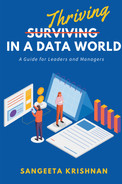1. IPhone Memory (n.d.).
2. Tabular processing system (n.d.).
3. World Bank (2014).
4. Ibid.
5. Ibid.
6. Self-Produced data (n.d.).
7. Faraway and Augustin (2018), pp. 142–145.
8. Kitchin and Lauriault (2018), pp. 463–475.
9. Faraway and Augustin (2018), pp. 142–145.
10. Ibid.
11. Bollier (2010).
12. Understanding Unconscious biat (n.d.).
13. Pandemic shopping (n.d.).
14. https://en.wikipedia.org/wiki/Datafication.
15. Normann (2007); Lycett (2013), pp. 381–386.
16. https://help.netflix.com/en/node/14164.
17. www.theregister.com/2022/02/10/google_analytics_gdpr_breach/; https://techcrunch.com/2022/01/12/austrian-dpa-schrems-ii/.
18. www.pewresearch.org/internet/2014/11/12/public-privacy-perceptions/.
19. Acquisti, Taylor, and Wagman (2026), pp. 442–492.
20. https://bluebutton.cms.gov/.
21. www.theregister.com/2022/02/10/google_analytics_gdpr_breach/; https://techcrunch.com/2022/01/12/austrian-dpa-schrems-ii/.
23. https://en.wikipedia.org/wiki/Data_economy.
24. Grand View Research (2021).
25. Movie Moneyball (n.d.).
26. Description of Technology Acceptance Model (n.d.).
27. Danielsson and Toss (2018).
28. Law, Endert, and Stasko (2020).
29. Ibid.
30. Psychology Today (n.d.).
31. Law, Endert, and Stasko (2020).
32. Yi, Kang, Stasko, and Jacko (n.d.), pp. 1–6.
33. Law, Endert, and Stasko (2020).
34. Law, Endert, and Stasko (2020); Yi, Kang, Stasko, and Jacko (n.d.).
35. Tool to use Python with Excel (n.d.).
36. Bilalli (2018).
37. Meyer and Avery (2009), pp. 91–112.
38. Elliott and Farber (2010), pp. 17–27.
39. Meyer and Avery (n.d.).
40. A/B testing (n.d.).
41. Augmented Analytics (n.d.); https://powerbi.microsoft.com/en-my/augmented-analytics/.
42. LinkedIn 2020 Emerging Job Trends (report). (n.d.).
43. Stitch (2016).
44. www.missingmaps.org/Missing Maps is an open data mapping project founded in 2014.
45. Smarter with Gartner (2021). GARTNER is a registered trademark and service mark of Gartner, Inc. and/or its affiliates in the United States and internationally and is used herein with permission. All rights reserved.
46. Statista (2021).
47. https://blog.seagate.com/.
48. www.bloomberg.com/opinion/articles/2022-01-12/supply-chain-woesare-convincing-ceos-to-bring-back-vertical-integration.
49. scrum.org and scrumguides.org
50. Agile Manifesto (n.d.).
51. https://en.wikipedia.org/wiki/Minimum_viable_product.
52. https://en.wikipedia.org/wiki/Kanban_(development).
53. Azevedo and Santos (2008).
54. Ibid.
55. Microsoft Documents (n.d.).
56. scrum.org and scrumguides.org (n.d.).
57. CARES Act (n.d.).
58. Bank of America (n.d.).
59. Mainali (2020).
60. DataKitchen white paper (n.d.).
61. https://icedq.com/dataops/dataops-implementation-guide.
62. Deshpande and Ruhe (2020).
63. https://en.wikipedia.org/wiki/Netflix_Prize.
64. Deshpande and Ruhe (2020); Ruhe and Nayebi (2016).
65. www.oxfordlearnersdictionaries.com/us/definition/english/literacy?q=literacy.
66. Sperry (2018).
67. Bloomberg Data for Good Exchange Conference (2015).
68. Smarter with Gartner (2021). GARTNER is a registered trademark and service mark of Gartner, Inc. and/or its affiliates in the United States and internationally and is used herein with permission. All rights reserved.
69. www.abc.net.au/news/2018-08-18/rainfall-forecasts-misunderstood-howto-make-sense-of-them/10093822; BOM (n.d.).
70. The COVID Tracking Project (n.d.).
71. https://en.wikipedia.org/wiki/Organizational_culture.
72. The Data Governance Institute (n.d.).
73. Manguel (1996).
74. Sander (2020).
75. Attention span (n.d.).
76. Picture Superiority Effect (n.d.).
77. Tactical Tech (n.d.).
78. Baby think it over (n.d.).
79. Definition of Persuasion (n.d.).
80. Fogg (2002).
81. Hagen (2012).
82. Fogg (2002).
83. Matei and Hunter (n.d.), pp. 312–322.
84. Data Ink (n.d.).
85. Visual impairment (n.d.).
86. Sutadi (2021), pp. 13–23.
87. Brain Processing (n.d.).
88. Analytics word origin (n.d.).
89. Rose, Brendtsson, Mathiason, and Larsson (2017), pp. 339–360.
90. Uber ride statistics (n.d.).
91. Surge Pricing (n.d.).
92. Behavior patterns (n.d.).
93. Yang, Shao, Wang, and Ye (2018).
94. Yang, Shao, Wang, and Ye (2018); www.cnbc.com/2018/11/13/uber-launches-new-customer-rewards-program.html; www.uber.com/legal/en/document/?country=united-states&lang=en&name=uber-rewards-benefit-terms.
95. Artificial Intelligence Definition (n.d.).
96. Machine Learning (n.d.).
97. www.reuters.com/article/us-amazon-com-jobs-automation-insight/amazon-scraps-secret-ai-recruiting-tool-that-showed-bias-against-women-idUSKCN1MK08G.
98. Google What If tool (n.d.).
99. https://theodi.org/article/what-is-a-data-trust/.
100. Europol (2020).
101. www.safegraph.com/; https://en.wikipedia.org/wiki/Data_as_a_service.
102. Auto ML (n.d.).
103. Zillow challenge (n.d.).
104. Zillow closing home buying business (n.d.).
105. Reddy and Jena (2010).
106. Bhardwaj, Karger, Subramanyam, Deshpande, Madden, Wu, Elmore, Parameswaran, and Zhan (2015).
107. Derakhshannia, Gervet, Hajj-Hassan, Laurent, and Martin (2019).
108. Dehghani (2019).
109. Varis (2018).
110. AI and RPA (n.d.).
